Samsung Galaxy S 6 and S 6 Edge: Preview
by Joshua Ho on March 26, 2015 9:00 AM EST- Posted in
- Smartphones
- Samsung
- Mobile
- Galaxy S6
- Galaxy S6 Edge
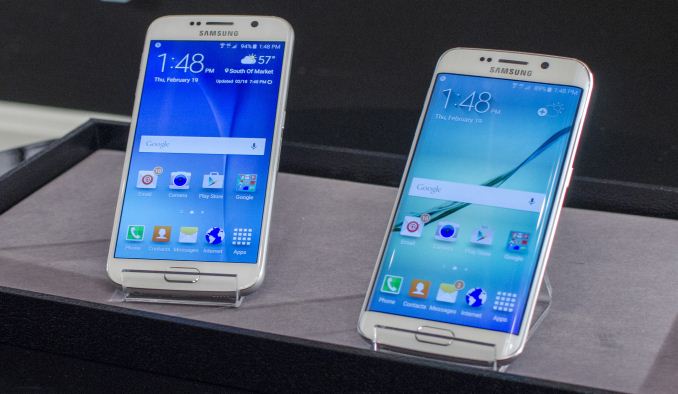
Yesterday we received our Galaxy S6 and S6 edge review units. We’re still working on the final review but I wanted to share some early results from both devices. For those that are unfamiliar with these two phones, the Galaxy S6 range represents the result of Samsung’s “Project Zero”. In fact, the phones seem to have the internal name of Zero, which can be seen in terminal, and the build properties of both devices. For Samsung, these phones represent their attempt at completely rethinking how Samsung makes phones. There is a strong emphasis on a new unibody design, which has no visible gaps or screws. Rather than the plastic that previous Samsung phones have been known for, the new design is composed of metal and glass. Samsung’s design team has been given unprecedented control throughout the process of making this phone and the result of this is a Galaxy phone that looks unlike anything else they’ve ever released.
Even if design is important, it isn’t enough to make the phone. Samsung has also outfitted the Galaxy S6 and S6 edge with their latest technologies, from a new AMOLED display to a new camera module. The specs for both phones can be seen below.
| Samsung Galaxy S5 | Samsung Galaxy S6 | Samsung Galaxy S6 Edge | |
| SoC | MSM8974ACv3 2.45 GHz Snapdragon 801 | Exynos 7420 2.1/1.5GHz A57/A53 | Exynos 7420 2.1/1.5GHz A57/A53 |
| RAM/NAND | 2GB LPDDR3 16/32GB NAND + microSD |
3GB LPDDR4-1552 32/64/128GB NAND |
3GB LPDDR4-1552 32/64/128GB NAND |
| Display | 5.1” 1080p SAMOLED HD |
5.1” 1440p SAMOLED |
5.1” 1440p SAMOLED, Dual Edge |
| Network | 2G / 3G / 4G LTE (Qualcomm MDM9x25 UE Category 4 LTE) | 2G / 3G / 4G LTE (Category 6 LTE) | 2G / 3G / 4G LTE (Category 6 LTE) |
| Dimensions | 142 x 72.5 x 8.1 mm, 145 grams | 143.4 x 70.5 x 6.8mm max, 138 grams | 142.1 x 70.1 x 7.0mm max, 132 grams |
| Camera | 16MP (5132 x 2988) Rear Facing with 1.12 µm pixels, 1/2.6" CMOS size, 31 mm (35mm effective), f/2.2 | 16MP (5132 x 2988) Rear Facing w/ OIS, f/1.9, object tracking AF | 16MP (5132 x 2988) Rear Facing w/ OIS, f/1.9, object tracking AF |
| 2MP Front Facing | 5MP Front Facing, f/1.9 | 5MP Front Facing, f/1.9 | |
| Battery | 2800 mAh (10.78 Whr) | 2550 mAh (9.81 Whr) | 2600 mAh (10.01 Whr) |
| OS | Android 4.4 w/TouchWiz |
Android 5 (64-bit) w/TouchWiz | Android 5 (64-bit) w/TouchWiz |
| Connectivity | 802.11a/b/g/n/ac 2x2 + BT 4.0 (BCM4354), USB3.0, GPS/GNSS, MHL, DLNA, NFC |
2x2 802.11a/b/g/n/ac + BT 4.1 (BCM4358), USB2.0, GPS/GNSS, NFC |
2x2 802.11a/b/g/n/ac + BT 4.1 (BCM4358), USB2.0, GPS/GNSS, NFC |
| Wireless Charging | N/A | WPC 1.1 (4.6W) & PMA 1.0 (4.2W) |
WPC 1.1 (4.6W) & PMA 1.0 (4.2W) |
| Fingerprint Sensor | Swipe | Touch | Touch |
| SIM Size | MicroSIM | NanoSIM | NanoSIM |
Both the Galaxy S6 and S6 edge have Samsung System LSI’s newest SoC, the Exynos 7420, which has a cluster of four Cortex A57s clocked at 2.1 GHz, and four Cortex A53s clocked at 1.5 GHz. Compared to the Exynos 5433 of the Galaxy Note 4, this brings a new 14nm LPE (low power early) process, an upgrade to LPDDR4 memory, and a Mali T760 GPU with two additional shader cores. Outside of the SoC, the new display is advertised to bring a higher 600-nit brightness and a higher 1440p resolution. The front and rear cameras are both different from the Galaxy S5 as well, although the rear camera sensor may be shared between the two as the camera sensors are of similar spec. For this preview, we’ll focus on the system performance and display of these new devices, but as one can see from the specification table there is far more to look at for the full review.
System Performance
For our system performance benchmarks we’ll start with our browser tests which can give a rough proxy for overall CPU performance.
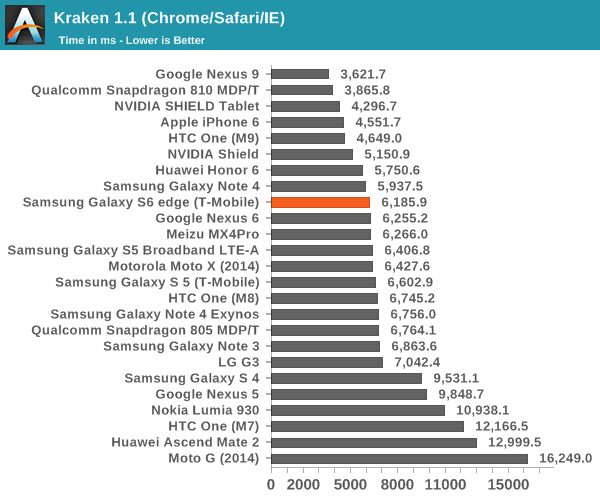
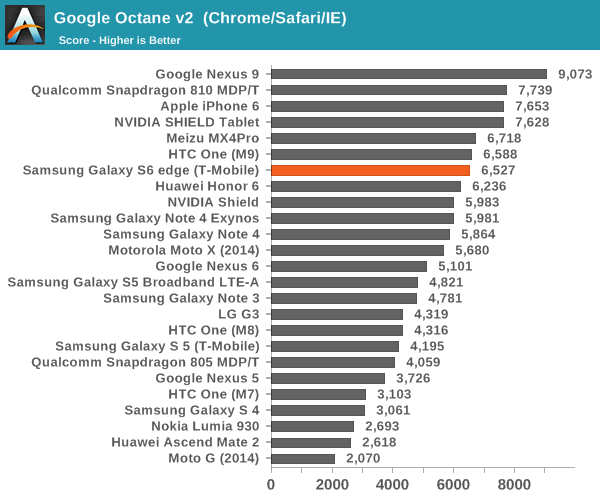
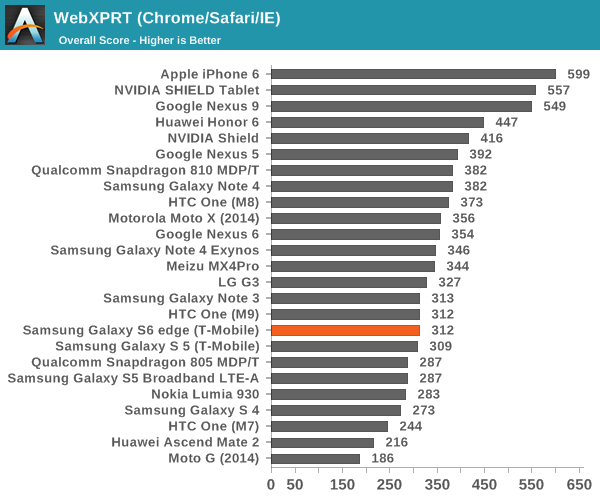
The Exynos 7420 is about on par with the Snapdragon 810 in these benchmarks. Strangely enough both tend to do worse than the Huawei Honor 6 in these tests, which clearly can't be correct. As we've previously discussed, the stock browser will often give far better results due to OEM and SoC vendor optimizations. As a part of our updates to the benchmark suite for 2015, we'll take a look at Basemark OS II 2.0, which should give a better picture of CPU performance in addition to overall device performance.
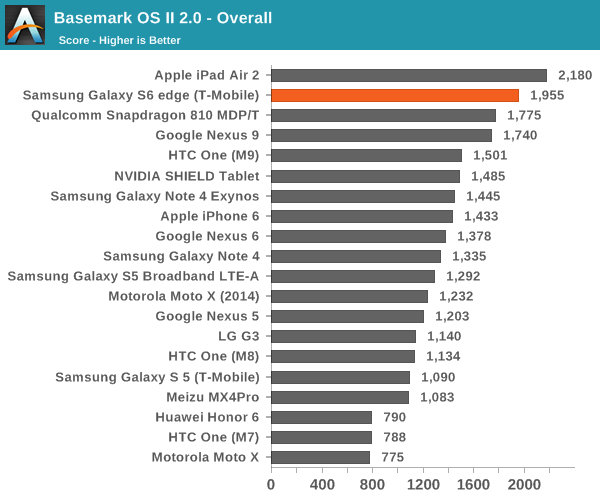
The browser benchmarks seem to hide some pretty enormous variability as the Galaxy S 6 edge (which is comparable to the Galaxy S 6) sets a new record among Android devices. The only challenger is the iPad Air 2, which uses the A8X SoC with three Enhanced Cyclone cores and the semi-custom GXA6850 GPU.
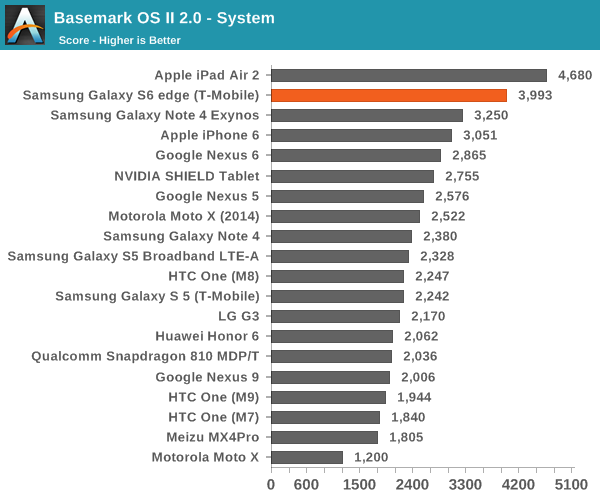
This system test contains a floating point and integer test, in addition XML parsing, which means that this test mostly stresses CPU and RAM. Interestingly enough, the Exynos 7420 pulls far ahead of both the Exynos 5433 and Snapdragon 810 in this test, and approaches the A8X. The difference between the 5433 and 7420 is likely a combination of the higher clocks on both the A57 and A53 clusters for the 7420 (1.9/1.3 on the 5433, 2.1/1.5 on the 7420), in addition to the ability to stay at a high 'overdrive' clock due to reduced leakage from the 14LPE process. The One M9 likely falls a bit short here due to HTC's governor settings restricting the use of all 8 cores simultaneously.
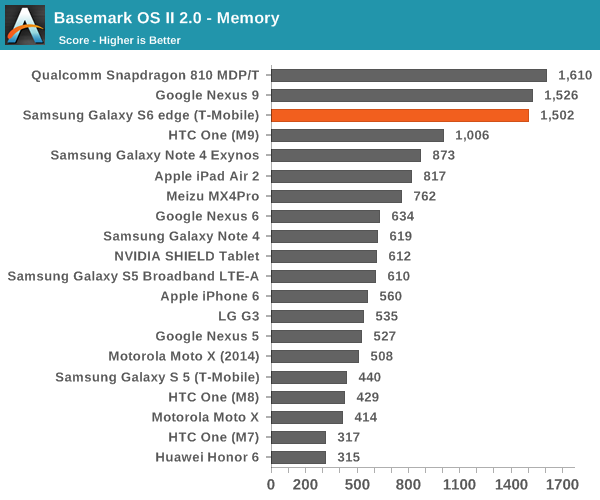
While one might guess that the memory test of 'Basemark OS II 2.0 - Memory' is of RAM, this is actually a test of the internal storage. Once again we see the S6 edge come close to leading the pack due to the use of the new UFS (Universal Flash Storage) standard. Casual examination reveals that the S6 edge has a queue depth of 16, and that it identifies itself with the rather cryptic model name of KLUBG4G1BD-E0B1.
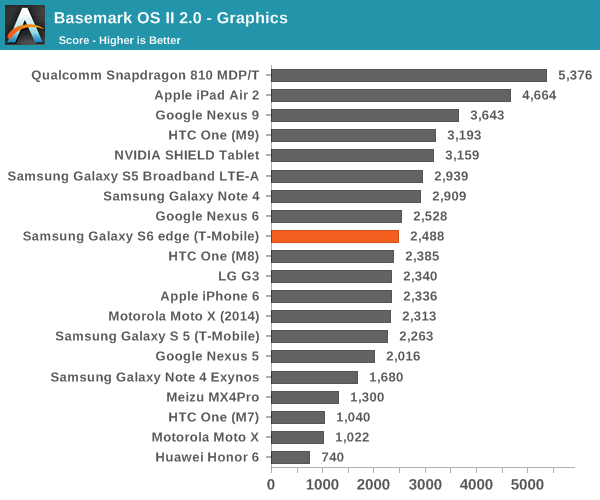
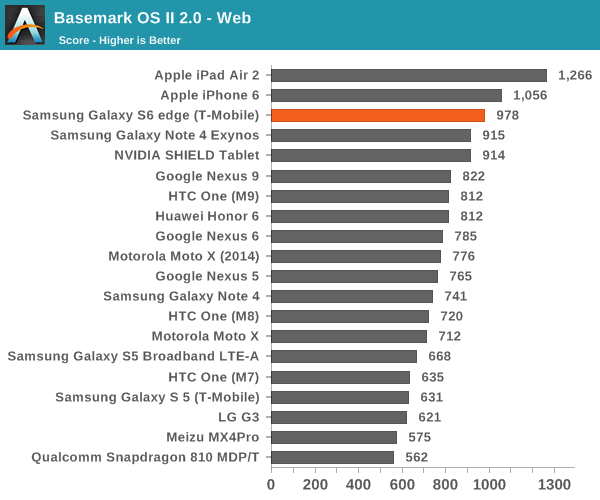
For the web test, it uses the built-in WebView rendering engine rather than Chrome and paints a distinctly different picture, especially because these tests are focused on HTML5 and CSS rather than JavaScript. Here we can see that the iPhone 6 and iPad Air 2 continue to hold their lead, but the Galaxy S6 is pretty much the king of the hill when it comes to Android devices.










200 Comments
View All Comments
mkozakewich - Thursday, March 26, 2015 - link
For most things, like games, they'll be running on a reduced resolution. You can expect high performance, then.makxon - Friday, March 27, 2015 - link
this! ya, a lot people just don't understandmelgross - Thursday, March 26, 2015 - link
A major problem with OLEDs which wasn't mentioned in the article, is that because of brightness issues, and yes, this display has them as well, they need that Pentile array to raise the brightness. But the Pentile display lowers resolution by about 30%. So they then need to raise resolution to make up for it. So a 1440 display isn't much sharper, in real world use, than a 1080 display.As far as why they don't allow that super brightness in manual use is not just because of battery use, but because of display heat. If they allow that to be used all the time, the display life, which is directly dependent on the heat generated, will be considerably shortened. It's also likely that the different colors have differing maximum brightness levels, so it can't be balanced at that high a level.
This are problems OLED manufacturers have been having from the beginning.
I would say that this is one of the best smartphone displays out there, but not THE best.
makxon - Friday, March 27, 2015 - link
no need to get humble, super amoled is the best display on any smartphone period.superflex - Friday, March 27, 2015 - link
Paid shill warning.TrojMacReady - Friday, March 27, 2015 - link
Lots of assumptions. Yes, LED life shortens with higher temperatures, but we don't know the temperatures, nor the current life expectancy (which has improved several times over the past years). And even without auto boost, visibility is great, not in the least thanks to a relatively low reflectivity. *Without* the boost, it's still much easier to read in high ambient lighting than the HTC M9 and no worse than an iPhone 6 (Plus), if not slightly better.Meaning, auto boost is actually a bonus beyond that.
TrojMacReady - Friday, March 27, 2015 - link
The GPU performance is great (class leading for phones) if you set it to your desired resolution (balance quality vs framerates) for the applications used.mkozakewich - Thursday, March 26, 2015 - link
This just requires better customer support from Samsung. They need to replace batteries that have lost significant health in less than two years.The other thing would be to post reminders that reducing the battery below 20% can damage it (conservatively speaking, of course.) I'd like to see them shut down the phone at 10%.
jbm - Thursday, March 26, 2015 - link
Yes, especially since on my two Android phones so far (S4 / S4 mini), I had nothing but a horrible experience with battery life. By that, I mean that the battery life is WILDLY INCONSISTENT even when doing the EXACT SAME things. I do not use my phone much. I do not play games on it, I do not watch videos or listen to music. I just use it as a phone (not many calls per day, mainly SMS and checking of mails). I always have the "power saving" mode active. Still, when doing the exact same things (leaving for work at 7am, putting the phone on the desk at work, going home at 5pm), on one day the phone is still at 90% battery when I leave work (about 1% per hour), on the next day it is only at 60%. When I got my S4 mini, I tried out the battery life and got nearly 3 days out of it. Then I charged it up, and the next day it went from full to 40% in one day. How can this be possible? What madness is this? All I can guess it that some system processes just go bonkers at random (the main battery usage according to the list always is "phone in standby"). I got a second battery together with a separate battery charger, and one thing I noticed is that when I power off the phone in the morning, take out the battery and replace it with the charged one (as opposed to actually charging the phone itself via USB cable and leaving the battery in), I never get the "mega battery drain".Oh, and on the S4 which I had before the S4 mini, the battery went dead within one year (the phone would turn itself off within 1-2 minutes after powering on).
Well, now enter the S6 without a replaceable battery. No, thanks. No Samsung for me anymore, and also no Android by anybody else.
Darkito - Thursday, March 26, 2015 - link
If your phone is rooted, download the BetterBatteryStats app. Some process is causing a wakelock and most of the time you just need to get rid of some offending app. I had an app that simulated Moto's Active Display and it was destroying battery life and not showing up in the regular battery stats screen.